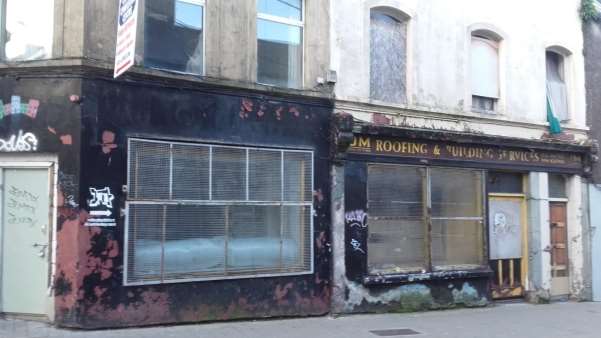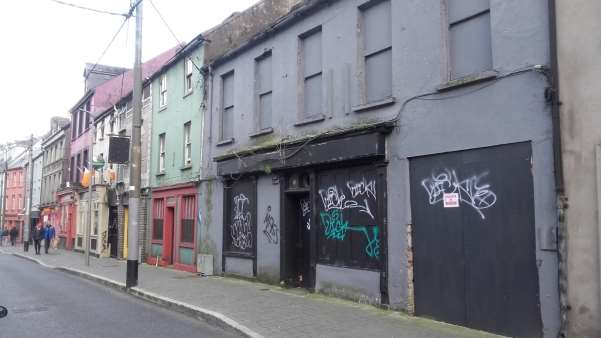Examples of Inner City Decline
the essay is guiding you to consider Barrack Street as an example of an inner city area, and evaluate it in the context of explanations used by geographers to explain the rise and fall of these kinds of neighbourhoods more generally.
To what degree is Barrack Street an example of inner-city decline?
Applied geography
Tutor: Dr. Denis Linehan
Seán Ó Dálaigh
#100207799
One example of inner-city decline, which is now present in the city of Cork, is Barrack Street and this illustrated essay shall examine as to what degree the Street has experienced this decline. The essay will mention briefly some of Barrack Street’s rich history and discuss how it has changed in its recent past to become presently a street that appears to have been let decline and deteriorate. This essay will discuss some initiatives and changes that are helping to reduce Ireland’s inner-city decline. The essay will consist of personal observations, made on a number of exploratory visits to Barrack Street, combined with referenced material.
Barrack Street has a rich cultural heritage and has been an intrinsic part of the history of Cork city. The area around present day Barrack Street was thought to have been first settled by Vikings and its connection to this past can be found in some of the place names of the lanes adjacent to Barrack Street. An example of this would be Keyser Hill, which is of Scandinavian origin, meaning the passageway leading to the wharf on the quayside. It would have been these Norse settlements of fishermen and traders that helped begin Cork’s long tradition as a commercial port and the commerce that went with them. In the 12th century the Normans turned Cork into a walled ‘city’ and for a number of centuries until the 1690s Barrack Street was the main southern route into the walled settlement through South Gate Bridge (Pettit, 1982). The prominent star shaped Elizabeth Fort was built adjacent to the Street in 1601 and it was a barracks for an English garrison until the early 1800s.
From the second half of the 18th century to the 1820s city of Cork experienced a large growth in population. Between the years of 1750 to 1821, Cork’s population grew from 41,000 to 80,000. This increase was partly due to changes in farming practices and the consolidation of rural holdings, which caused people from rural areas to migrate into the city, but also owing to the fact that Cork’s economy and trade had increased significantly during this period. By the end of the 18th century Cork city had become a large export trade harbour; exporting mainly beef, pork, dairy and textiles. The many different trades and industries that went into the making of these produce required a large labour force. As a result of this, during the 19th century Cork’s city centre had become overpopulated which caused the expansion of the city’s population in the areas beyond the North and South Gate bridges; Shandon Street and Barrack Street respectively. But these decades of Cork’s economic prosperity did not last. The city’s economic decline was mainly due to falling agricultural prices in Britain, the collapse of the Cork’s textile industry caused by the import of cheaper surplus British manufactured goods and also the halting of the provision trade caused by the ending of Napoleonic wars. Together with this decline came an increase in unemployment and deteriorating living conditions (O’Brien, 1993).
By the mid- 19th century it was estimated that almost 70% of the city’s population lived in slums. At the end of the 19th century the area around Barrack Street, along with areas in the vicinity of Shandon Street and west of the Marsh, still had some of the worst slums in the city. At the same time, and in contrast to these slums and their destitute population, there was a growing middle class who could afford to live in the new emerging suburbs. Away from the inner city.
It was not until the earlier part of the following century that improvements were made to these areas. These improvements came in the form of new housing schemes, which at the time helped to stem the decline around Barrack Street and the rest of the city’s slums (Hourihan, 1993).
In recent years, before Ireland’s economic crash in 2008, Barrack Street had experienced an amount of prosperity with a large amount of the street’s premises being occupied by small commercial businesses. A Cork website called ‘foundmark.com’, which was last updated in 2006, lists many of the businesses on Barrack Street from a decade ago. From a recent survey I undertook of the street the majority of these businesses mentioned in this list have since closed down. The street, 10 years ago, had a variety of small businesses like fruit and veg shops, Asian and Afro-Caribbean stores, butchers, a shoe repairs, home décor, a hardware store ‘JM Roofing & Building Services’ (Fig.1), a guesthouse and more pubs (foundmark.com, 2006). Many of these premises are now unoccupied and in a state of dereliction (Fig. 2). At the time that this survey was taken roughly 30 buildings of the Street’s 144 premises, approximately 21%, were untenanted or appeared completely neglected. It is quite evident that in recent years the Street has become another example of inner-city decline.
During this survey, a number of interviews were made with local residents living on the street to hear about their views, experiences and opinions on Barrack Street’s current condition. One of these interviewees was Mrs Breda Twomey who grew up at the family run grocery shop on the street. She acknowledged the decline still apparent on the street, blaming high corporations taxes and rates, but felt optimistic for the Street’s future. She believed that the recent one-way system, which was implemented in 2012, and the new Elizabeth Fort heritage attraction have brought more business to the street; and that the future development of the Beamish Crawford site, will also have a positive impact on Barrack Street. Also interviewed was one of the members of the former fruit and veg shop ‘The Lettuce Inn’, which was part of a squatted building on the street. This occupier cited his reason for squatting was that he was tired of seeing derelict or vacant buildings on the street being left idle, while at the same time many people in Cork City could not find housing. He felt having this squatted building gave them an opportunity to provide a fruit and veg shop for the Street’s residence. Unfortunately, after 14 months in business the ‘Lettuce Inn’ had to close earlier this year, to the disappointment of many local residents; but there is still a lot optimism with residents and businesses for the future of the Street.
In recent years in Ireland there has been a number of positive initiatives and projects that are addressing issues of urban decline and vacancy in areas like Barrack Street. In 2014, Dublin City Council held an event called ‘City Limits- Inventive Uses for Urban Spaces’ which focused on vacant or unused spaces within cities and demonstrated more creative uses for these kind of spaces while also helping to reduce urban decline. One of the outcomes of this event was to highlight the need for a ‘vacant land levy’ to be introduced (O’ Callaghan & P. Lawton, 2015) and in 2015 a new law ‘The Urban Regeneration and Housing Bill’ was passed by the Irish Government ‘to adopt new measures to incentivise the use and development of vacant sites’ (The Urban Regeneration and Housing Bill 2015, p. 2). In 2015 Cork City
Council published its City Development Plan in which it stated that it would ‘encourage the development of cultural or tourist venues and the promotion of cultural events’ within areas close to important sites like Elizabeth Fort and that they would also ‘assist the growth of cultural, tourist related and small to medium scale cultural business activities such as bars, restaurants and small offices suitable for cultural businesses’ in the areas of Cork’s inner city which include Barrack Street (Cork City Development Plan 2015-2021, p.192). The Council has also funded the ‘Regeneration Area Building Improvement Grant’ which is a scheme that ‘covers repair works to buildings that are unsightly and in a poor condition’ around the Barrack Street area.
‘The cost of failure to solve the problems of our cities will be paid in the lives of misery for many of the inhabitants. The reward of well thought out, dynamic policies could be cities of beauty and opportunity where men and women can decide for themselves how they will work, live and enjoy their leisure’ p.21 These are some of the positive changes and initiatives that are helping to reduce inner-city decline around Cork and Ireland; and Barrack Street’s culture history, as mentioned earlier in this essay, could indeed be an asset to help it grow from this decline. This essay has also examined some of the commercial changes and decline that has occurred to the street since the economic crash. The person survey, which was undertaken for the essay, has demonstrated some of the current opinions and optimisms of some of the local residents; and it is hoped that these attitudes will help change the tide of inner-city decline that Barrack Street has experienced.
 Fig. 1
Fig. 1

Fig. 2
Bibliography
O’ Callaghan & P. Lawton, 2015. Temporary Solution? Vacant Space policy and strategies for
re-use in Dublin. Irish Geography, Foley, R. (ed), vol. 48(1), pp. 69-87.
http://www.corkcitydevelopmentplan.ie -accessed on 15 October 2016
http://www.corkcity.ie/paintingandbuildingimprovementgrantschemes/ -accessed on 8 October 2016
-accessed on 15 October 2016
http://www.foundmark.com/ito/Corkcity-Online/tour/pages -accessed on 8 October 2016
http://www.housing.gov.ie/housing/policy/housing-market/radical-new-legislation-passed-tackle-vacant-and-idle-land-and-improve -accessed on 8 October 2016